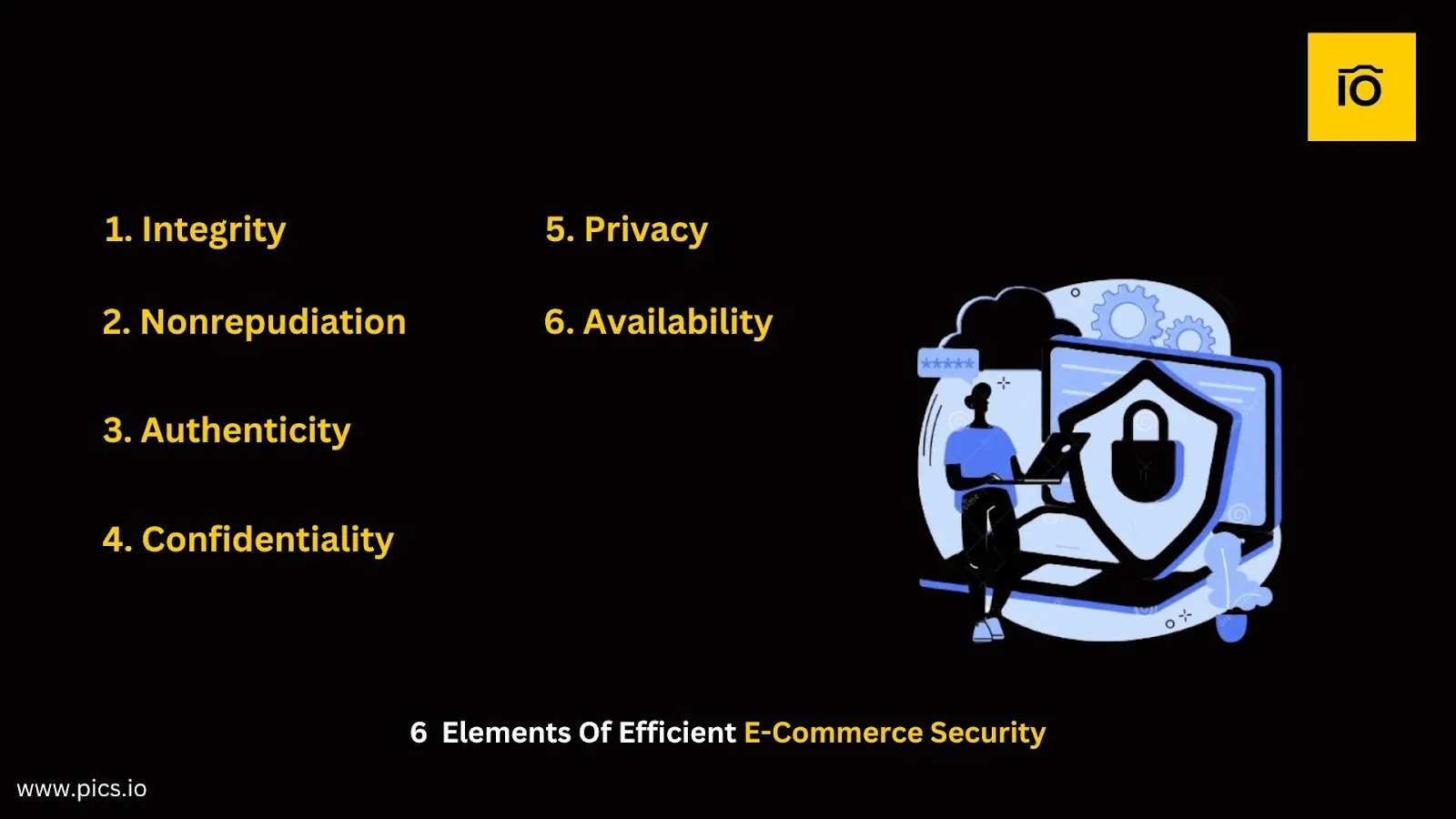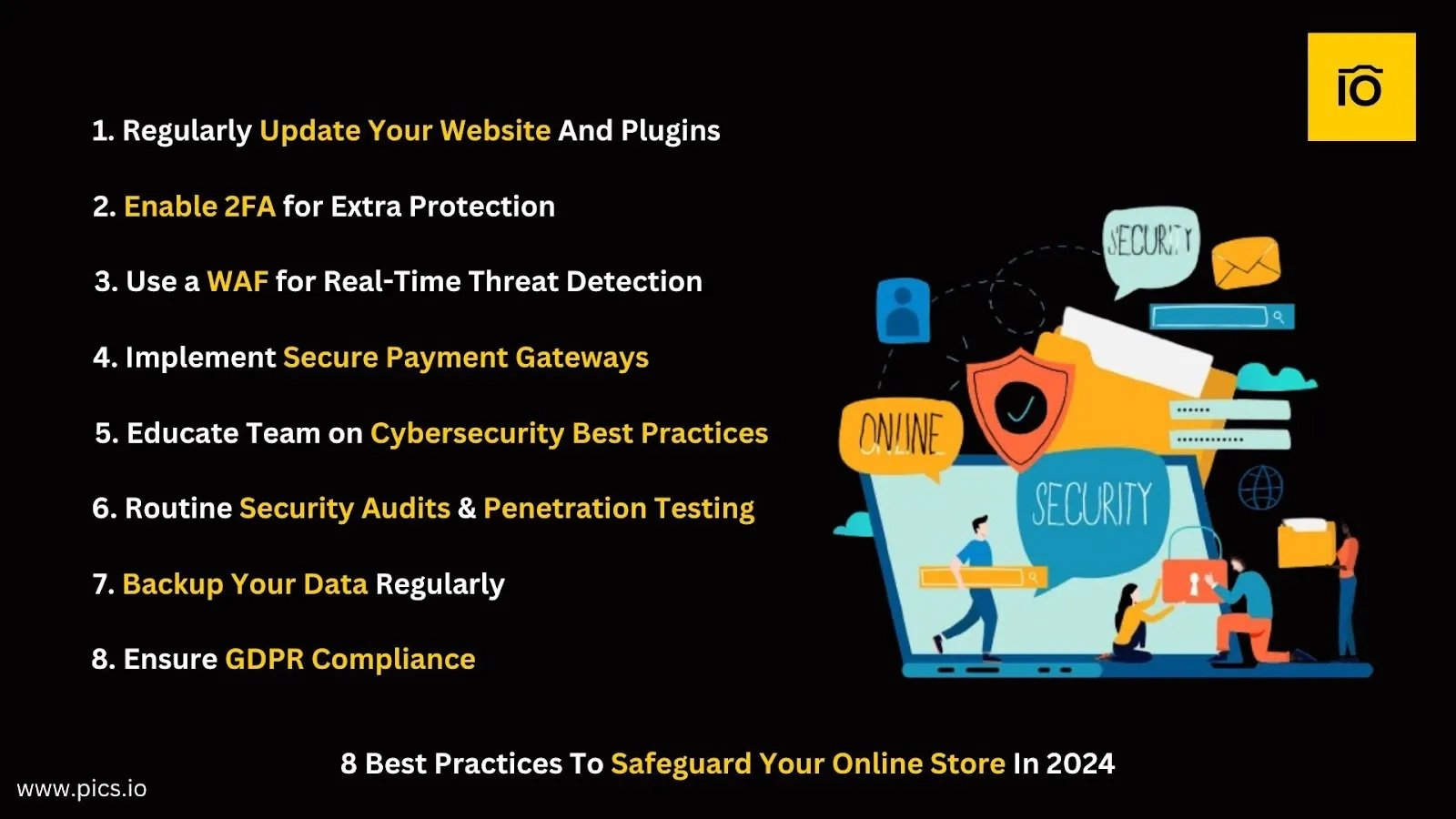In this article, you’ll learn:
Data breaches in the U.S. cost businesses over $9 millions as of January 2023. Additionally, the country ranks 2nd globally for identity theft incidents affecting customers. This makes safeguarding your store from such threats a top priority.
You should be confident in your store’s e-commerce security so you can focus on the creative side of your business without constant worry. But protecting your online store shouldn’t be expensive or require a dedicated team of cybersecurity experts.
In this article, we’ll share some simple, cost-effective steps to help you secure your online store. You can implement these strategies in just a few hours.
But first, let’s clarify—what exactly is e-commerce security?
What Is E-Commerce Security, Anyways?
E-commerce security is all about maintaining your online store’s security by protecting it from hackers, frauds, or any other threats that could harm your business or customers.
Why is eCommerce Security Important?
“It takes 20 years to build a reputation and a few minutes of cyber-incident to ruin it.” — Stephane Nappo, Security Officer at Groupe SEB.
When you run an online store, you’re dealing with customers' personal information, like credit card details and addresses.
If this information gets into the wrong hands, it could lead to financial loss, a damaged reputation, and loss of trust from your customers.
Keeping your site secure protects both you and your customers from these risks.
Let’s understand this with the help of an example: Imagine you run an online store selling handmade jewelry. One day, a small security issue allows someone to access the email addresses of a few of your customers.
Those customers could start getting spam or phishing emails, especially if you’re using a free email API service without proper security measures, and they’ll likely blame your store. They also may never shop with you again, and word could spread that your store isn’t safe.
But, if you had strong E-commerce security in place, this situation could have been prevented.
6 Key Elements Of Efficient E-Commerce Security
To maintain the security of your online store, here are 6 elements of E-commerce security that you should focus on.
We’ll explain each with an example that focuses on a real-world use case:

1. Integrity
Integrity ensures that data cannot be altered without authorization. This means that the information in your online store, like product prices or customer details, remains accurate and untouched unless you or an authorized person changes it.
Imagine you run an online store selling home appliances.
Integrity ensures that no one can secretly change the price of a product after a customer has placed an order.
This way, both you and the customer are protected from fraud or errors.
2. Nonrepudiation
Nonrepudiation means that once a customer or a business completes a transaction, they cannot deny it later.
This is crucial for holding parties accountable in online transactions.
For example, if a customer purchases a new laptop from your store, nonrepudiation ensures that they can’t later claim they didn’t make the purchase.
This protection helps resolve disputes fairly.
3. Authenticity
Authenticity confirms that the data or information you’re dealing with is from a legitimate source. It helps ensure that your store is communicating with real customers or vendors.
Let’s say you receive an order for a large number of products. Authenticity checks confirm that the order is genuinely from a verified customer and not from a fake account or scammer.
4. Confidentiality
Confidentiality protects sensitive information, such as customer data and payment details, from being accessed by unauthorized parties. It’s like keeping your customers' private details in a secure vault.
A customer buys a smartwatch from your store through his credit card.
Confidentiality ensures that their credit card information is encrypted and cannot be seen by anyone other than the payment processor.
5. Privacy
Privacy allows customers to control who has access to their personal data and how it’s used. It’s about respecting and protecting customer information.
If a customer signs up for your newsletter, privacy means you’ll only use their email for sending updates and won’t share it with third parties without their consent.
6. Availability
Availability ensures that your E-commerce site and its data are accessible when needed. This means your store is always up and running, and customers can browse and buy without interruptions.
Let’s say your online store sells popular gadgets.
Availability ensures that your site stays online even during a big sale event such as Christmas or Black Friday, making sure to prevent any delays or downtime that could frustrate customers.
When enhancing your online store’s security, it's not just about protecting customer data; you also need to ensure that your promotional activities are safeguarded from fraud or misuse.
Effective trade promotion optimization can help you streamline your marketing efforts while ensuring that your promotional campaigns are secure and error-free.
8 Best Practices To Safeguard Your Online Store In 2024
This isn’t 2022 anymore.
As new technologies emerge, attackers are finding new ways to sneak into your system.
Here are some effective strategies you can implement to improve your online store’s security in 2024:

1. Regularly Update Your Website and Plugins
Keeping your website’s software, including themes and plugins, up to date ensures that any known security vulnerabilities are patched.
Set a schedule to check for updates weekly and update plugins after each development cycles or sprints.
If you run a WordPress store, an outdated plugin could be a weak point that hackers exploit. Consider using a plugin management tool to automate updates and keep track of any changes.
Regular updates close these security gaps as developer specifically implement them keeping security as the first priority.
2. Enable Two-Factor Authentication (2FA) for Extra Protection
Adding 2FA to your login process adds a second layer of security, requiring both a password and a code sent to your phone or email. To support this, you can integrate a verify API that sends one-time codes via SMS or voice whenever customers log in or perform sensitive actions.
If you or a staff member log into your store's admin panel, 2FA ensures that even if someone guesses the password, they can’t get in without the additional code.
Generally, 2FA is implemented for all user accounts, especially for admin and other high-privilege users.
This prevents unauthorized access and reduces the risk of account takeovers.
Use 2FA solutions like Google Authenticator or Authy, which are free and easy to integrate.
Also, encourage your customers to enable 2FA for their accounts to further enhance security.
3. Use a Web Application Firewall (WAF) for Real-Time Threat Detection
A WAF monitors your site’s traffic and blocks malicious requests in real-time, preventing threats from reaching your site.
For an online store, a WAF helps stop harmful traffic, such as bots trying to find weaknesses in your site.
Invest in a reputable WAF service, such as Cloudflare or Sucuri, that offers real-time protection against threats like SQL injection and cross-site scripting (XSS).
You can also encourage developers to review your WAF logs to identify and address potential threats proactively.
This proactive protection keeps your store running smoothly without interruptions.
4. Implement Secure Payment Gateways to Protect Customer Data
For online stores selling items, using a secure payment gateway ensures that customers’ credit card details are encrypted and safe from hackers.
Be sure to use a trusted payment gateways such as Stripe or Paypal. These payment gateways keep updating their policies frequently to stay updated with security attacks.
Also, ensure your payment gateways comply with the latest Payment Card Industry Data Security Standard (PCI DSS).
Using trusted payment gateways like these ensures that your customers’ payment information is handled securely, whether they're paying through online invoices or other methods.
5. Educate Your Team on Cybersecurity Best Practices
Human error is often the weakest link in security.
For example, if an employee accidentally clicks on a phishing email, it could give hackers access to your store’s admin panel.
Making sure your staff is well-informed and vigilant can significantly reduce the likelihood of security incidents.
Educating your team on cybersecurity best practices is one of the most critical defenses against potential breaches.
It involves regular training sessions that cover various aspects of online security, such as:
- How to recognize phishing emails
- Importance of using strong and unique passwords
- Secure ways to handle sensitive customer data
- Following procedures that minimize risks
And more.
6. Conduct Regular Security Audits and Penetration Testing
Regularly reviewing your site’s security measures and testing them against potential threats helps you identify and fix vulnerabilities before they become a problem.
Suppose your store has grown rapidly. A security audit helps ensure that new features or changes haven’t introduced security risks.
Normally, security audits are scheduled quarterly to review your website's security measures and identify any vulnerabilities.
If your budget allows, hire a cybersecurity expert to perform penetration testing, which simulates real-world attacks to expose weak spots in your defenses.
You can then document these findings and create an action plan to address any issues.
7. Backup Your Data Regularly to Prevent Losses
Regular backups ensure that if your site is compromised, you can quickly restore it to a previous, uncorrupted state.
The frequency of backups differs from business to business. Moreover, you don’t have to manually backup your site every single time.
You can automate daily backups of your website and databases to ensure that you can quickly restore operations in case of a cyberattack or system failure.
For backups related to media files, content, or videos, you can use simple and free solutions like Google Drive. Additionally, you can take help from different backup tools to simplify the process of backing up your data on Google Drive.
8. Ensure GDPR Compliance to Protect Customer Privacy
If you’re based in EU or sell products to EU-based customers, the General Data Protection Regulation (GDPR) sets strict guidelines on how businesses must handle personal data of EU customers.
Here’s a short guide to making your online store GDPR-compliant using free tools, whether you’re on WordPress, Shopify, or any other platform:
- Create a Privacy Policy:
For this, you can use a free privacy policy generator like Termly or FreePrivacyPolicy. Fill out the required fields, and they will generate a tailored policy for your store.
- Add a Cookie Consent Banner:
- WordPress: Install a free plugin like CookieYes or GDPR Cookie Consent.
- Shopify: Use the free "GDPR Cookie Banner" app from the Shopify App Store.
- Other Platforms: Look for free cookie consent tools or use services like Cookiebot.
- Collect Explicit Consent:
- WordPress: Update forms with a checkbox using plugins like WPForms Lite or Contact Form 7.
- Shopify: Use a free app like "GDPR Cookie Banner" to add consent checkboxes to forms.
- Other Platforms: Ensure forms include consent checkboxes using built-in form features or free form tools.
- Ensure Secure Data Handling:
- WordPress: Use a free SSL certificate with a plugin like Really Simple SSL.
- Shopify: Shopify provides SSL automatically for all stores.
- Other Platforms: Check if your platform provides SSL or use a free SSL service like Let's Encrypt.
- Facilitate Data Requests:
- WordPress: Create a contact form with WPForms Lite or Contact Form 7 for data access/deletion requests.
- Shopify: Add a simple contact form using Shopify's built-in tools or free apps.
- Other Platforms: Use available form tools to set up a way for users to request their data.
- Limit Data Collection:
- WordPress: Configure forms and data collection settings to ask only for necessary information.
- Shopify: Adjust form fields and data collection settings in the admin panel.
- Other Platforms: Review and limit data collection fields according to GDPR requirements.
- Educate Your Team:
Find free online guides or courses about GDPR to educate your team on data protection best practices.
Conclusion
Securing your online eCommerce store in 2024 is more crucial than ever as cyber threats continue to evolve alongside new technologies.
Remember, security isn’t just about technology—it’s about staying informed, being proactive, and ensuring that everyone involved in your business is prepared to face the challenges of today’s digital landscape.
Did you enjoy this article? Give Pics.io a try — or book a demo with us, and we'll be happy to answer any of your questions.
Natasha MerchantA content marketing specialist with over 6 years of experience, Natasha loves creating content marketing strategies for businesses. She has written for various publications and is currently helping SaaS companies improve their online visibility through SEO, content marketing, and link building.




